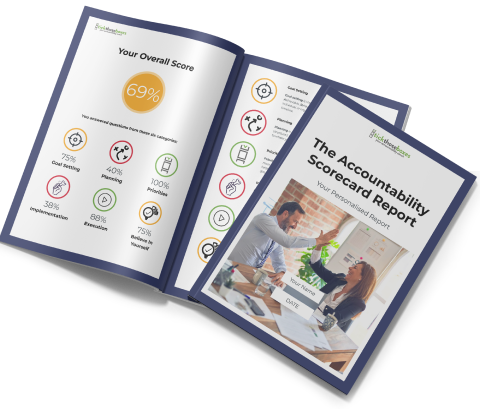
Accountability for Business Owners
Learn how accountability can help business owners build more sustainable
The Accountability Guy®

Accountability is the cornerstone of personal growth, effective teamwork, and organisational success. The “Accountability Ladder” is a powerful model that illustrates various levels of responsibility, from avoidance and blame to proactive problem-solving and leadership. In this blog, we delve into each of the eight classes on the Accountability Ladder and explore strategies to identify and address these levels for personal and professional development.

Discover your Accountability Score and increase the probability of smashing your GOALS and Getting Sh!t Done!
Level 1: Victim Mentality
The Victim Mentality represents the lowest rung on the Accountability Ladder. Individuals at this level view themselves as helpless victims of circumstances, attributing their successes or failures solely to external factors. To address this level, self-awareness is critical. Recognise when you feel powerless and shift your mindset toward taking control of your choices and actions. Practice self-reflection and focus on solutions rather than dwelling on problems.
Level 2: Denial and Avoidance
At this level, individuals deny their responsibility for outcomes and avoid acknowledging their mistakes. To address denial and avoidance, practice introspection and recognise your errors. Embrace vulnerability and admit when you’ve made a misstep. By facing the truth, you can grow and learn from your experiences.
Level 3: Blame Game
The Blame Game involves acknowledging mistakes but quickly shifting responsibility to others. To address this level, foster open communication. Instead of placing blame, focus on the bigger picture and engage in collaborative problem-solving. Taking collective responsibility can lead to a more constructive and accountable work environment.
Level 4: Justification
Individuals at the Justification level provide excuses or rationalisations for their actions. To address this level, practice self-accountability. Instead of explaining away your behaviour, own up to your actions and their consequences. This shift in mindset encourages personal growth and builds trust with colleagues.
Level 5: Shame or Guilt
At this level, individuals acknowledge their mistakes but experience shame or guilt. To address these emotions, practice self-compassion. Understand that making mistakes is a natural part of growth. Focus on learning from your errors and channel that knowledge into positive actions.
Level 6: Obligation
Individuals at the Obligation level fulfil their responsibilities but need more enthusiasm. To address this, connect your tasks to your values and long-term goals. Understand the impact your efforts have on the team and organisation. This shift in perspective can infuse a sense of purpose and commitment into your work.
Level 7: Responsibility
Taking responsibility is a significant step on the Accountability Ladder. Individuals at this level accept ownership of their actions and actively work to rectify mistakes. To further enhance this level, embrace a growth mindset. See challenges as opportunities for growth and continuous improvement. Seek feedback and actively seek solutions when issues arise.
Level 8: Self-Accountable
The Self-Accountable level involves holding yourself to high standards and actively seeking growth. To continue progressing:
Navigating the eight levels of Accountability requires ongoing self-awareness, reflection, and a commitment to personal and professional growth. By identifying where you stand on the Accountability Ladder, you can take actionable steps to ascend to higher levels of responsibility.
To address these levels effectively:
Remember that the journey up the Accountability Ladder is ongoing and non-linear. Each step represents an opportunity for growth and transformation. By consistently addressing the eight levels of Accountability, you can cultivate a culture of responsibility that benefits both yourself and your organisation.

Darren Finkelstein, The Accountability Guy®, is the founder of TICK THOSE BOXES, a specialised accountability coaching practice. Darren is a formidable international accountability coach, business advisor, mentor, and author/speaker, fostering development and measurable results in entrepreneurship, leadership, and accountability. Darren’s tale is one of perseverance, self-reinvention, and resilience.
With compelling execution, Darren has empowered high-achieving individuals and teams from Australia and New Zealand to Latin America, Europe, Asia, the UK, and the US to embrace accountability; after all, it is your superpower.
Darren’s one-on-one and group coaching programs are based on his bestselling business book, “The Accountability Advantage – Play your best game” and the latest, release “NO’ – Building a life of choice without obligation”.
Darren has an impressive background in business, having held the role of “Manager of Commercial Markets” at Apple Australia during the Steve Jobs revolution.
He enthusiastically “walks the talk,” having also successfully sold and exited his lifestyle businesses, which served as the impetus for establishing his coaching and mentoring business.
Join Darren on this transformative quest to accomplish the remarkable.
Read Darren’s full bio here:
https://tickthoseboxes.com.au/about/

Know what to do first

know what to do next

know what to do more of

Learn how accountability can help business owners build more sustainable

Boost productivity and trust within your team. Unveil the power

Learn about Positive Accountability, see what it is, why you

Accountability drives success in so many ways. Whenever I coach

Are You Responsible or Accountable? The underlying principles undoubtedly apply

Discover why accountability is crucial for effective leadership. Learn how
Navigation
Learn More
Contact
Social Media
Copyright Darren Finkelstein 2022 | Privacy Policy | Terms and Conditions